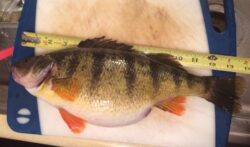Not all fishermen make, or report “honest” measurements. One study found that anglers tend to skew fish sizes, and catches, by at least 20%! This can especially become an issue when legal rules and limits apply.
I once was ice fishing an area in Middle River, Maryland. Yellow perch were the target fish, and the bite was on. The limit was 10 perch over 9 inches in length. I was returning a lot of smaller fish so 9 of my perch were well over 13 inches in size. One perch was gut hooked so I kept a smaller fish rather than let it go to waste. 
The Game Warden stopped me as I left the ice. He had been watching me through binoculars and thought I had kept over the limit. My count was on, but one perch was dramatically smaller, and stood out next to the other bigger fish. He laid his tape measure on that fish every way he could, but it was still one inch longer than the size limit required. He was confused why I had kept the smaller fish.
Exact measuring is important. Sometimes an inch can be gained or lost if you are not measuring the fish correctly.
Use an accurate measure tool. Tape measures can be cloth, metal, a ruler, marks on the rod, or net. Do the Math accurately
Never touch the fish with the measurer. You do not want to wipe, scrape, or remove any of the fishes protective mucous coating. Lay/ hold the fish alongside the measure tool.
The contour doesn’t count. Laying the tape over and along the fish curve adds length but is not legal. Contour only counts with girth. This is usually after the fish is already dead.
Fish Tails are not all square or even. The correct way to measure the tail is to fold the caudal fin tips together. Measure from that longest tip, not inside the forked tail. 
The nose Knows. Measure from the fishes furthest nose end.
Many estimates can be a quick measure. Making marks on your nets, rods, paddle, cooler, or other tool can give you a quick and close guess. If the fish is close, measure more precisely. If you are using a net, wet it first before touching the fish. This is essential when abiding by slot limits.
When I was a young trout fisherman, the minimum size to keep some trout was 7 inches. If you spread your thumb and little finger apart, that was 7 inches.
If you are measuring fish for a record, time is essential. Fish shrink after they end up in the cooler or on a stringer. Pictures of the fish and a ruler, with a size comparison, are helpful. Go the check station or FWP/DNR office asap.
Being a good Sportsman is about following the rules. There is no excuse if you don’t. Stick to size and possession limits. There is always another day to go fishing.
Size matters!
Montana Grant